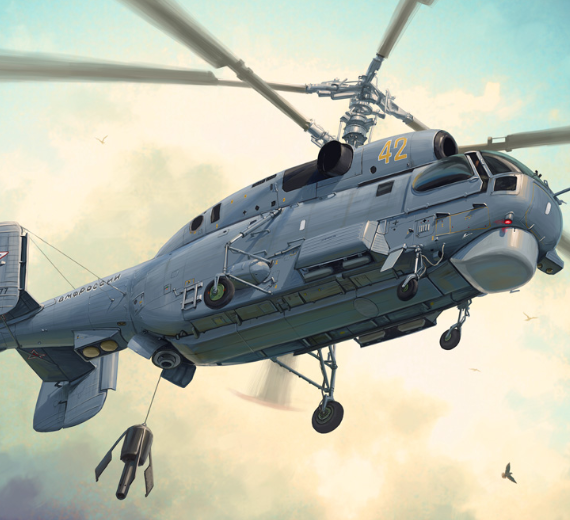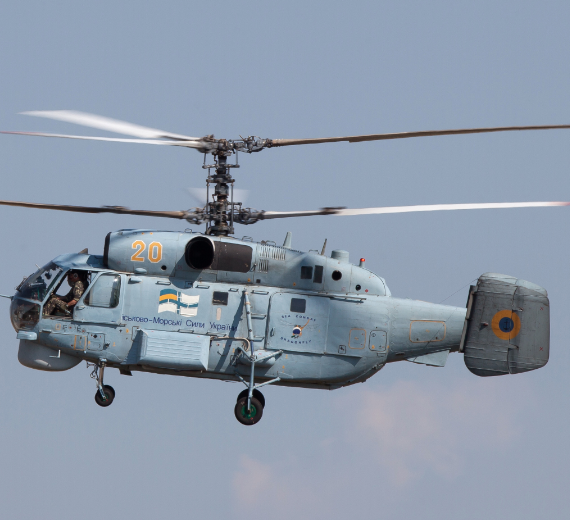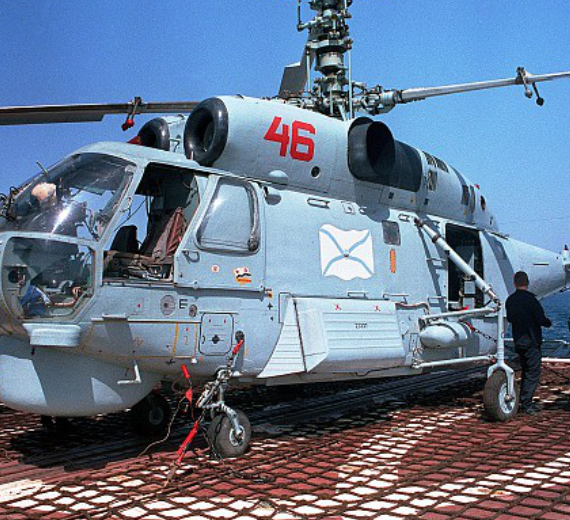JSC Kamov Design Kamov Ka-27 'Helix'
 |
|
| A Russian Navy Ka-27 flying by USS Vella Gulf over the Gulf of Aden. | |
| Role | Anti-submarine warfare helicopter |
|---|---|
| National origin | Soviet Union / Russia |
| Manufacturer | Kamov |
| First flight | 24 December 1973[1] |
| Introduction | 1982 |
| Status | In service |
| Primary users | Soviet Navy (historical) Russian Navy Ukrainian Navy Indian Navy |
| Produced | 1979–2010 |
| Developed from | Kamov Ka-25 |
| Variants | Kamov Ka-31 |
|
|
|---|
.
History JSC Kamov Design Bureau
Kamov Ka-27 NATO reporting name 'Helix'
-
Design
A Russian Navy Ka-27PS Characteristics
The helicopter was developed for ferrying and anti-submarine warfare. Design work began in 1969 and the first prototype flew in 1973. It was intended to replace the decade-old Kamov Ka-25, and had to have identical or smaller external dimensions than its predecessor. Like other Kamov military helicopters it has coaxial rotors, removing the need for a tail rotor. In total, five prototypes and pre-series helicopters were built. Series production started at Kumertau in July 1979, and the new helicopter officially entered service with the Soviet Navy in April 1981
Variants
Military
A Russian Navy Ka-27PS 
Ka-29 - Ka-252
- First prototype.
- Ka-27K
- Anti-submarine warfare prototype.
- Ka-27PL
- (Helix-A) Anti-submarine warfare helicopter.
- Ka-27PS
- (Helix-D) Search and rescue helicopter, ASW equipment removed and winch fitted.
- Ka-27PV
- Armed version of the Ka-27PS. read more
0
KmCeiling
0
KmMAX RANGE
0
Km.hAircraft Speed
0
Max Crew
Photo Gallery
JSC Kamov Design Bureau
Kamov Ka-27 NATO reporting name 'Helix'


JSC Kamov Design Bureau
Kamov Ka-27 NATO reporting name 'Helix'
General characteristics
- Crew: one-three, plus two-three specialists (Ka-27)
- Capacity: 4,000 kg (8,818 lb) payload (Ka-32), or up to 16 troops (Ka-29).
- Length: 11.3 m (37 ft 1 in)
- Height: 5.5 m (18 ft 1 in)
- Empty weight: 6,500 kg
-
Powerplant
- Gross weight: 11,000 kg
- Max takeoff weight: 12,000 kg
- Powerplant: 2 × Isotov TV3-117V turboshaft engines, (2,230 hp) each
- Main rotor diameter: 2 × 15.8 m
Specifications
- Maximum speed: 270 km/h
- Cruise speed: 205 km/h
- Range: 980 km
- Service ceiling: 5,000 m
Armament
-
-
-
Ka-29TB
- 1 × mobile forward firing GShG-7.62 machine gun with 1800 rounds,
- 1 × 30 mm 2A42 cannon with 250 rounds (flexible semi-rigid mount, optional/removable with ammunition carried in cabin)
- four external hardpoints for bombs, rockets, gunpods, munitions dispensers, special four round missile launchers for the 9K114 Shturm
-
-
-
-
Links to Youtube & Others
Ka-32s are used for construction of transmission towers for overhead power lines, as it has somewhat higher lift capacity than the Vertol 107. In Canada, the Ka-32 is used for selective logging as it is able to lift selective species vertically
Kamov Design Bureau
Kamov Ka-27 'Helix'
The Z-19 can primarily conduct attack, armed reconnaissance and scout missions. It is capable of destroying enemy tanks and other land-based targets.
Youtube Link
The helicopter has a length of 12m and height of approximately 4.01m. Maximum take-off weight is 4,500kg, whereas the empty weight is 2,350kg.











.png)


.png)